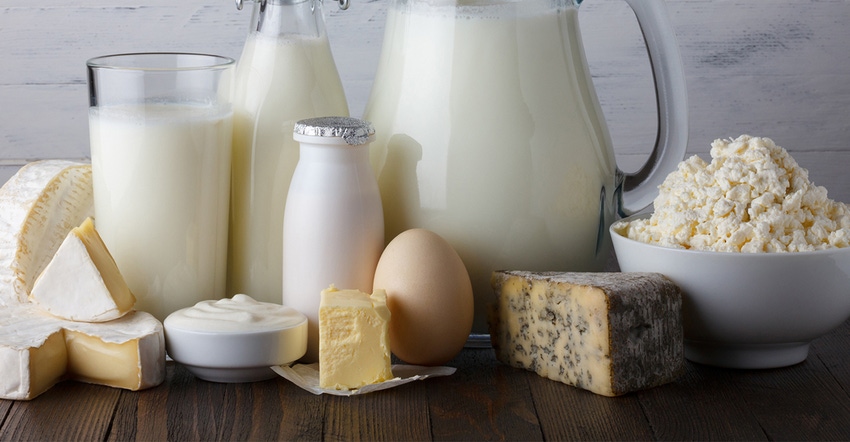
Nate Donnay, director of dairy market insight for INTL FCStone Financial Inc.’s FCM Division, says dairy producers are rightly concerned about continued low milk prices and the potential for a trade war with China.
“Class III milk primarily gets its value from two components: cheddar cheese and dry whey. Most of the cheese sold in the United States is priced off the CME spot cheese market, and the only cheese that can trade there is fresh cheddar, aged between 4 and 30 days,” Donnay explains. “So, the important driver for cheese pricing is the production and exports of cheddar each month. We’ve seen a slowdown in cheddar production in recent months, moving from 2.7% growth in the fourth quarter to just 0.3% in January.”
Donnay says exports have also been growing, and are up about 19% from January 2017. He says if cheddar production continues to be restrained and exports remain good, there is no reason the cheese market couldn’t average in the $1.60s during the second half of the year.
Weak sales of mozzarella
“The problem is mozzarella,” Donnay says. “The U.S. consumes more mozzarella than cheddar, and domestic mozzarella sales have been weak — down an estimated 1.3% in 2017. That has led to a buildup of mozzarella inventories that are estimated up 10.7% from February 2017. If we can’t generate better demand for mozzarella, milk is going to start to flow away from it, and one likely place it will end up is cheddar. So, we’re cautiously optimistic on strengthening cheese prices, with the biggest concern — outside of trade wars — [being] weak mozzarella demand that might push more milk into cheddar.”
Donnay says the second big driver for Class III is dry whey.
“Whey markets were very heavy in 2017, but we’re starting to see some improvement in late 2017,” he says. “U.S. exports were better than expected in the second half of the year, and in January, global imports hit a new record high.”
Donnay says U.S. inventories are now being drawn down; domestic buyers are stocking up at low prices; exports are moving; dry whey prices in Europe moved higher in March; and it looks like U.S. whey prices are starting to carve out a bottom.
“We’ve been expecting the market to start shifting a little higher in April, and that looks like it is going to play out,” he says. “However, we have some new concerns that might limit the upside. First, a lot of the whey [and lactose] that is imported into Asia ends up in hog feed, and the price of hogs in China has dropped 30% since the start of the year as new large-scale farms have come on line. Those large-scale farms tend to be the big users of whey products in the ration, so their existence should be supportive on the demand side. But if their margins are getting squeezed, they are going to be shrewd negotiators on prices.”
Trade war
The second bearish concern on whey, Donnay notes, is the potential for a trade war with China. He says in 2017, about 47% of the whey and whey protein concentrates exported out of the U.S. went to China, along with 20% of U.S. whey protein isolate and 17% of U.S. lactose.
“Altogether, about 20% of the milk solids exported out of the U.S. last year went to China,” Donnay says. “So far, China has not threatened to raise import tariffs on U.S. dairy products in retaliation for the U.S. raising tariffs against Chinese imports. But China is threatening to raise the tariff on other products by 15% to 25%.”
Donnay says if China increases tariffs on U.S. products, he thinks a reasonable estimate is that U.S. prices will fall [from what they otherwise would have been] by about half of the percentage increase in tariffs.
“Right now, our forecast whey price for the second half of the year is about 32 cents per pound,” he says. “If China put a 25% tariff on U.S. whey, that would likely drop the forecast by 12.5%, or about 4 cents.
If we bring together a forecast CME block cheese price of $1.675 during the second half of 2018 [assuming mozzarella consumption picks up soon] and a dry whey price of 32 cents per pound [assuming no increase in Chinese tariffs], we come up with a Class III milk price averaging around $15.83,” he predicts.
“If we take a more pessimistic view and say that China will raise tariffs on U.S. whey products, that likely drops the Class III price to about $15.59,” Donnay says. “If domestic mozzarella sales don’t pick up and more milk gets pushed into cheddar, we could be looking at CME block cheese down in the high $1.50s. If we combine the trade war scenario with weak mozzarella sales, we get a Class III price around $14.58.”
About the Author(s)
You May Also Like






